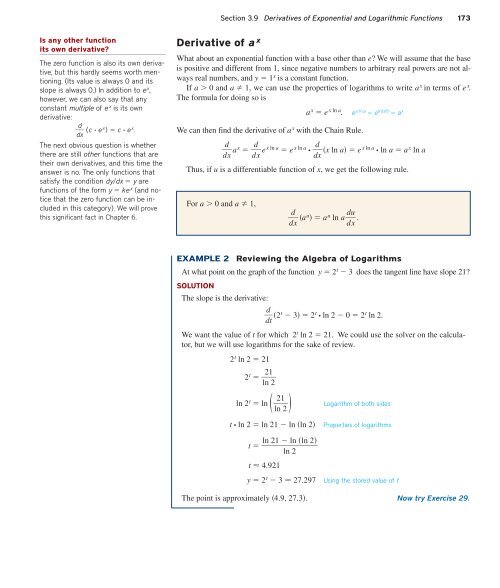5128_Ch03_pp098-184
Create successful ePaper yourself
Turn your PDF publications into a flip-book with our unique Google optimized e-Paper software.
Section 3.9 Derivatives of Exponential and Logarithmic Functions 173<br />
Is any other function<br />
its own derivative?<br />
The zero function is also its own derivative,<br />
but this hardly seems worth mentioning.<br />
(Its value is always 0 and its<br />
slope is always 0.) In addition to e x ,<br />
however, we can also say that any<br />
constant multiple of e x is its own<br />
derivative:<br />
d<br />
(c • e x ) c • e x .<br />
d x<br />
The next obvious question is whether<br />
there are still other functions that are<br />
their own derivatives, and this time the<br />
answer is no. The only functions that<br />
satisfy the condition dydx y are<br />
functions of the form y ke x (and notice<br />
that the zero function can be included<br />
in this category). We will prove<br />
this significant fact in Chapter 6.<br />
Derivative of a x<br />
What about an exponential function with a base other than e? We will assume that the base<br />
is positive and different from 1, since negative numbers to arbitrary real powers are not always<br />
real numbers, and y 1 x is a constant function.<br />
If a 0 and a 1, we can use the properties of logarithms to write a x in terms of e x .<br />
The formula for doing so is<br />
a x e x ln a . e x lna e ln(ax) a x<br />
We can then find the derivative of a x with the Chain Rule.<br />
d<br />
a d x<br />
x d<br />
e d x<br />
x ln a e x ln a d<br />
• x ln a e d x<br />
x ln a • ln a a x ln a<br />
Thus, if u is a differentiable function of x, we get the following rule.<br />
For a 0 and a 1,<br />
d<br />
a d x<br />
u a u du<br />
ln a .<br />
d x<br />
EXAMPLE 2<br />
Reviewing the Algebra of Logarithms<br />
At what point on the graph of the function y 2 t 3 does the tangent line have slope 21?<br />
SOLUTION<br />
The slope is the derivative:<br />
d<br />
2 d t<br />
t 3 2 t • ln 2 0 2 t ln 2.<br />
We want the value of t for which 2 t ln 2 21. We could use the solver on the calculator,<br />
but we will use logarithms for the sake of review.<br />
2 t ln 2 21<br />
2 t 21<br />
<br />
l n 2<br />
ln 2 t ln ( 21<br />
ln<br />
)<br />
Logarithm of both sides<br />
2<br />
t • ln 2 ln 21 ln ln 2<br />
t ln 21 ln ln 2<br />
<br />
ln 2<br />
t 4.921<br />
y 2 t 3 27.297<br />
Properties of logarithms<br />
Using the stored value of t<br />
The point is approximately 4.9, 27.3. Now try Exercise 29.












